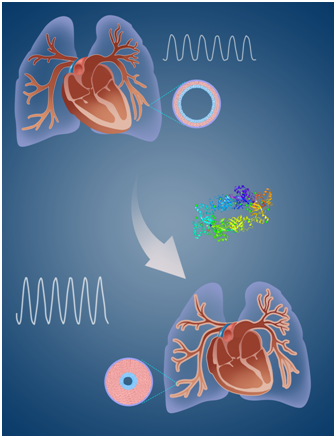Pulmonary arterial hypertension (PAH) is the high lung blood pressure that results from narrow or blocked arteries in the lungs. It is a life-threatening condition that impacts tens of thousands of people every year. Researchers around the world have been studying PAH to try to find ways to prevent, control, and treat it for many years.
Recently, a research team led by Professor Jinsong Bian (Pharmacology, School of Medicine) published their research in the high impact academic journal, Circulation Research (IF = 14.467). Their paper, entitled, “Periostin: A Potential Therapeutic Target For Pulmonary Hypertension?” sought to explain how periostin, a novel protein found in the lungs, causes the damage from PAH.
The current treatment methodology for PAH focuses on relieving the symptoms rather than significantly improving the overall disease for the patient. PAH still sees high death rates in adults and the elderly suffering from lung diseases. Finding a new treatment pathway is urgent if PAH sufferers are to recover from the disease.
Dr. Jinsong Bian’s team found that the levels of periostin are significantly higher in patients suffering from PAH. They also found that there is a positive correlation between plasma periostin levels and the function of the right ventricle. This positive correlation provides a marker to predict the outcome of PAH.

Figure 1: periostin expression is upregulated in pulmonary arterioles and associated with pulmonary artery systolic pressure
In their experiments on mice, the research group found that the suppression of periostin would generate therapeutic effects against PAH. In contrast, increasing periostin reduced the body’s responses against PAH. The underlying mechanism involves the activation of hypoxia-induced factor-1a and its related signaling proteins.
These results suggest that inhibiting the level of periostin could present a positive treatment pathway for PAH. The researchers proposed that the manipulation of periostin could be a useful therapeutic target in treating PAH.
The researchers have demonstrated, for the first time, that periostin is a critical focus for future research into the treatment of PAH. Small molecules that target periostin provides ideal pathways for PAH drug development. The positive correlation between periostin and the function of the right ventricle provides a predictive marker for PAH outcomes, adding additional diagnostic tools for health care professionals.

Figure 2. Proposed signaling mechanisms for the role of periostin in the development of pulmonary hypertension
Dr. Xiaowei Nie from the Second Affiliated Hospital of SUSTech (Shenzhen Third People’s Hospital) is the first author of the paper. Dr. Jinsong Bian, Dr. Xiaowei Nie, and Dr. Jingyu Chen are the co-corresponding authors. Additional contributions came from the National Lung Transplantation Center at Wuxi People’s Hospital.
This research received support from the National Natural Science Foundation of China.
Proofread ByYingying XIA
Photo BySchool of Medicine, Yan QIU